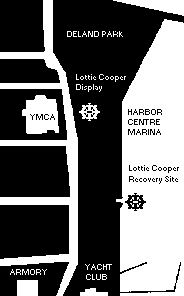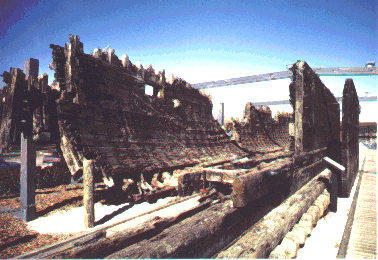

The remains were under 15 feet of water. Dredging for the Marina project required that the wreckage be removed. It was lifted with a back hoe in Sep 1992.


What to do with it? In 1993, the City of Sheboygan decided to display the remains. Artifacts of this size are unique. Very few Great Lakes shipwrecks have been recovered. Afloat, the Lottie Cooper was one of two thousand schooners that sailed the Great Lakes carrying passengers and cargo during the last 170 years. Wrecked, she represents one of some 700 ships lost on Lake Michigan and at least ten thousand wrecked in the Great Lakes. Sixty-two ships sank near Sheboygan. Fourteen ships went down within the city limits.*
The Lottie Cooper was launched by Rand & Burger Shipyard of Manitowoc, WI, 30 Mar 1876 and was named for the daughter of one of the original owners. The vessel was 131 feet long, 27 feet wide, 9 feet in depth of hold, and measured 250 gross tons. She represents a historic period when thousands of commercial wooden sail and steam vessels worked the dangerous waters of the Great Lakes. The 19th-century lake schooner was the 18-wheeler semitrailer truck of its day, and the Grate Lakes was its super highway.
The hull was planked inside and out with oak. Notice how the hull planks taper and curve upwards toward the bow and stern. Ribs (frames) can be seen through gaps where planks are gone. The curved portions of the frames were sawn from curved tree sections known as compass wood. The natural curves of the tree produced parts of great strength.
The edges of the planks were beveled. Caulkers drove a rope-like material called oakum into the groove between the planks to prevent the ship from leaking. The caulkers were supposed to be the most highly skilled men in the shipyards.
The holes about halfway up the side of the ship are salt ports. Salt was poured through these holes into the bilge. It mixed with water to form brine which helped preserve the bottom of the ship.
Near the top of the existing structure (starboard, right) you will note a square window-like opening. This is the lumber port through which boards up to 16-feet long could be loaded directly into the hold. Four hatches on deck provided access to the hold, as well.
The ship's decks and railings (bulwarks) were swept away during the storm that wrecked her. The bulwarks would have added another three feet to the sides. Notice the large U-shaped hole near the top. After the Lottie Cooper capsized, the owners decided the ship was a total loss. When she drifted up onto the beach the next day, workmen chopped this huge hole in her side to remove her cargo of timber.
The upright post mounted to the larger triangular section is the rudder post. The triangle is the deadwood which supported the rudder post. The ship's main cabin contained the Captain's quarters, a galley, and an eating area. It was located above this portion of the keel.
The mainmast soared 123 feet (five stories) above the deck. The mizzenmast (aft) stood 93 feet above the deck. The foremast and the mainmast each had four shrouds (heavy steel cables that kept the mast from tipping); the shortest mizzenmast had three. The shrouds attached to chain plates on the hull. The chain plates you see belong to the mainmast.
The centerboard, fitted through the keel of the ship, was housed in the centerboard trunk, a vertical water-tight box. 25½ feet long x 9 feet high, the centerboard was raised and lowered by means of a winch and chain located on the deck.
Weighing over a ton, the centerboard of the Lottie Cooper could be suspended as far as 20 feet below the keel to prevent the vessel from slipping sideways through the water when sailing abeam or up into the wind. Thus, it significantly improved stability and maneuverability when the schooner was under sail.
Because Great Lakes schooners served many small communities located on relatively shallow waters, they needed to be able to lower their center boards while under sail and raise them when they entered shallow harbors, rivers, and canals.
The windlass, a winch-like device mounted crosswise on the foredeck of the ship was used to raise the anchors. The anchor chains were brought aboard the vessel through hawse pipes (metal-lined openings in the bow). The chains were passed around the windlass, which was turned manually with heavy ratchets, to raise the anchors. The anchors weighed several tons, and raising them was a slow, laborious task that could require as much as half a day. Consequently, the anchors were dropped only when absolutely necessary.
The Lottie Cooper and thousands of schooners like her were constructed of white oak which grew in great abundance in Wisconsin in the mid-19th century. These ships were built in the small shipyards that existed at the mouths of many rivers on the Great Lakes including the Sheboygan River.
Each of these beautiful vessels could be built in four months or less by workmen skilled in trades that are now all but forgotten. The hardy shipbuilders worked outdoors from sunup to sundown, in all types of weather performing backbreaking tasks that few workmen today would even consider.
While large shipyards often used steam-powered equipment, small yards depended on hand tools almost exclusively, and every timber frame, plank, and spar was cut and shaped by hand. Each piece, some weighing thousands of pounds, was lifted into place with the most rudimentary equipment. As an example of the workmanship involved in the creation of these vessels, consider the effort needed to drive thousands of hand-forged spikes, some over four feet long, to secure the rock-hard white oak structural members.
The Lottie Cooper's preservation is a tribute to the great skill and craftsmanship of these dedicated workmen.
¹"The Remains of the Lottie Cooper," Bill Wangemann, ![]() City of Sheboygan Historian, City of Sheboygan, 1995.
City of Sheboygan Historian, City of Sheboygan, 1995.
Photo: Capt Jeffrey A Fox, ![]() Silent World Divecenter, Inc
Silent World Divecenter, Inc
16 Feb 97